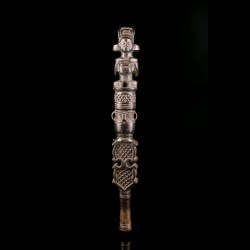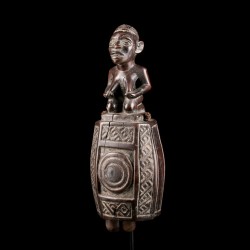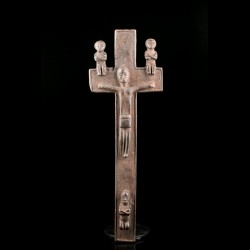




























This remarkable scepter-snuffbox was the property of an important Mwananganga chief of the northern Chokwe. It belongs to the so-called "Moxico" style, identified by Bastin; very similar to that of the Royal Museum for Central Africa bearing the reference RG. 41233, collected at Sandoa in Congo. This type of prestigious traditional object was made to order from an experienced sculptor. This scepter was carried by a servant who preceded or followed the chief during his official movements. When the chief stopped, the servant planted the scepter in the ground.
This beautifully sculpted emblem of power consists of two interlocking parts. The oldest known examples date from the mid-19th century but there may be older ones according to Marie-Louise Bastin. These prestigious objects are most often surmounted by a male or female representation having a protective function. It may actually be an effigy of the chief himself or one of his ancestors.
The small tobacco container is called ngoma, and is typically Chokwe. It is surmounted by a cover bearing a character playing the cisanji cakakondo provided with a calabash and a resonance chamber, a frequent instrument in the Chokwe culture.
The well-typed hairstyle worn by the character is referred to as cipenya-mutwe was worn by the dignitaries.
Finally, the flattened part decorated with geometric patterns bears the name of maswi a yisakala. Very well known in traditional Chokwe art, it imitates the net structure that makes up the wire mesh of the bird cages that birds and other ethnic groups from Angola took on their travels.
Data sheet
You might also like

This remarkable scepter-snuffbox was the property of an important Mwananganga chief of the northern Chokwe. It belongs to the so-called "Moxico" style, identified by Bastin; very similar to that of the Royal Museum for Central Africa bearing the reference RG. 41233, collected at Sandoa in Congo. This type of prestigious traditional object was made to order from an experienced sculptor. This scepter was carried by a servant who preceded or followed the chief during his official movements. When the chief stopped, the servant planted the scepter in the ground.
This beautifully sculpted emblem of power consists of two interlocking parts. The oldest known examples date from the mid-19th century but there may be older ones according to Marie-Louise Bastin. These prestigious objects are most often surmounted by a male or female representation having a protective function. It may actually be an effigy of the chief himself or one of his ancestors.
The small tobacco container is called ngoma, and is typically Chokwe. It is surmounted by a cover bearing a character playing the cisanji cakakondo provided with a calabash and a resonance chamber, a frequent instrument in the Chokwe culture.
The well-typed hairstyle worn by the character is referred to as cipenya-mutwe was worn by the dignitaries.
Finally, the flattened part decorated with geometric patterns bears the name of maswi a yisakala. Very well known in traditional Chokwe art, it imitates the net structure that makes up the wire mesh of the bird cages that birds and other ethnic groups from Angola took on their travels.


